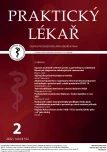Nutrition as primary support of immunity
Authors:
P. Šíma 1; V. Bencko 2
Authors‘ workplace:
Mikrobiologický ústav AV ČR v. v. i., Praha, Laboratoř imunoterapie, Ředitel: Ing. Jiří Hašek, CSc.
1; Univerzita Karlova, Praha, 1. LF a VFN, Ústav hygieny a epidemiologie, Přednosta: prof. MUDr. Milan Tuček, CSc.
2
Published in:
Prakt. Lék. 2022; 102(2): 51-54
Category:
Reviews
Overview
The article summarizes the history of discovery of the relationship between nutrition and immunity. The idea of promoting good health through a right diet was already known to ancient physicians, as evidenced by Hippocrates’ (460–337 BC) quote, "If you know nothing about a person’s diet, how can you understand his illnesses." Diet not only has a nutritional meaning, but also has a direct effect on immunity. In this context, it is important to realize that every diet contains antigens that directly induce an immune response in our largest immune organ, the intestinal lymphoid tissue (GALT), which is always accompanied by the development of immunological memory, both immune specific (adaptive), as has recently been shown, non-specific immunity, which is referred to as "trained immunity". However, this time-tested experience has often been forgotten for many decades, as is the case in the history of human cognition, and especially in the history of medicine.
Diet not only has a nutritional significance, but also it has a direct effect on immune status. In this context, it is important to realize that every diet contains antigens that directly induce an immune response in our largest immune organ, the intestinal lymphoid tissue (GALT), which is always accompanied by the development of immunological memory, both specific (adaptive) immunity, and as it has recently been shown, non-specific (natural) immunity, which is referred to as "trained immunity". In essence, food intake therefore means ongoing vaccination, a constantly recurring induction of immunological memories of both types, the specific (adaptive), and the non-specific (trained).
Keywords:
nutrition as primary prevention – communicable disease – GALT – specific (adaptive) and non-specific (natural) immunity – immunological memory – trained immunity
Sources
1. Thorwald J. Science and the secrets of early medicine. NewYork: Harcourt, Brace and World 1962.
2. Ackerknecht EH. Therapeutics from the primitives to the 20th century with and appendix: history of dietetics. New York: MacMillan Publishing 1973.
3. Bencko V. Postuláty Roberta Kocha a současná medicína založená na důkazu. Hygiena 2021; 66(3): 102–106.
4. Lind J. An essay, on the most effectual means, of preserving the health of seamen, in the Royal Navy: containing, cautions necessary for those who reside in, or visit, unhealthy situations: with directions, proper for the security of all such, as attend sick persons in fevers: and an appendix of observations, on the treatment of diseases in hot climates. Edinburgh: A. Millar, A. Kincaid, and A. Donaldson MDCCLVII [1757].
5. Bay A. Beriberi in modern Japan: the making of a national disease. Rochester: University of Rochester Press 2012.
6. Jackson CM. The effects of inanition and malnutrition upon growth and structure. Philadelphia, PA: Blakiston’s Sons & Co. 1925.
7. Beisel WR. History of nutritional immunology: introduction and overview. J Nutr 1992; 122(3 Suppl): 591–596.
8. Simon J. A physiological essay on the thymus gland. London: H. Renwhaw 1845.
9. Jeliffe N. Textbook of clincal nutrition. New York: Harper & Brothers 1950.
10. Chandra RK. Nutrition and imunology: from the clinic to cellular biology and back again. Proc Nutr Soc 1999; 58(3): 681–683.
11. Chandra RK. Nutrition, immunity, and infection. Mechanisms of interactions. New York: Springer Verlag Inc. 2012.
12. Santoni G, Cardinali C, Morelli MB, et al. Danger- and pathogen- associated molecular patterns recognition by pattern-recognition receptors and ion channels of the transient receptor potential family triggers the inflammasome activation in immune cells and sensory neurons. J Neuroinflammation 2015; 12: 21.
13. Matzinger P. Tolerance, danger, and the extended family. Ann Rev Immunol 1994; 12: 991–1045.
14. Matzinger P. The evolution of the danger theory. Expert Rev Clin Immunol 2012; 8(4): 311–317.
15. Medzhitov R, Janeway C. Innate immune recognition: mechanisms and pathways. Immunol Rev 2000; 173: 89–97.
16. Kumar H, Kawai T, Akira S. Pathogen recognition by the innate immune system. Int Rev Immunol 2011; 30(1): 16–34.
17. Schroeder K, Tschopp J. The inflammasomes. Cell 2010; 140: 821–832 doi: 10.1016/j.cell.2010.01.040
18. Vetvicka V, Sima P, Vannucci L. Trained immunity as an adaptive branch of innate immunity. Int J Mol Sci 2021; 22: 10684.
19. Kurtz J, Franz K. Innate defence: evidence for memory in invertebrate immunity. Nature 2003; 425(6953): 37–38.
20. Kurtz J. Specific memory within innate immune systems. Trends Immunol 2005; 26(4): 186–192.
21. Netea MG, Quintin J, van der Meer JWM. Trained immunity: a memory for innate host defense. Cell Host Microbe 2011; 9(5): 355–361.
22. Šíma P, Turek B, Bencko V. Betaglukany-imunomodulační látky v prevenci a podpůrné léčbě. Prakt. Lék. 2015; 95(6): 244–248.
23. Geller A, Yan J. Could the induction of trained immunity by b-glucan serve as a defense against COVID-19? Frontiers Immunol 2020; 11: 1782.
24. Torrence PF. (Ed). Biological response modifiers. Orlando: Academic Press, Inc. 1985.
Labels
General practitioner for children and adolescents General practitioner for adultsArticle was published in
General Practitioner

2022 Issue 2
Most read in this issue
- Nutrition as primary support of immunity
- The importance of personal internal feelings ("gut feeling") of general practitioners in the diagnosis of oncological diseases
- Patient experience with the use of information and communication technologies in primary care during the COVID-19 pandemic
- Nezapomínáte na prevenci? Přeočkování proti tetanu je stále důležité
